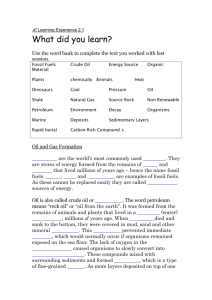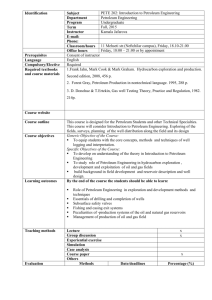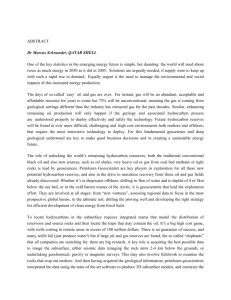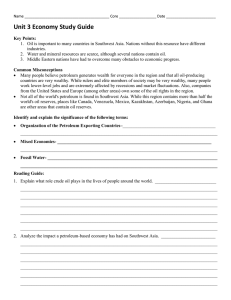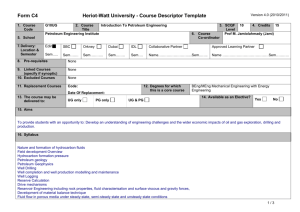Hydrocarbon Exploration and Production
advertisement
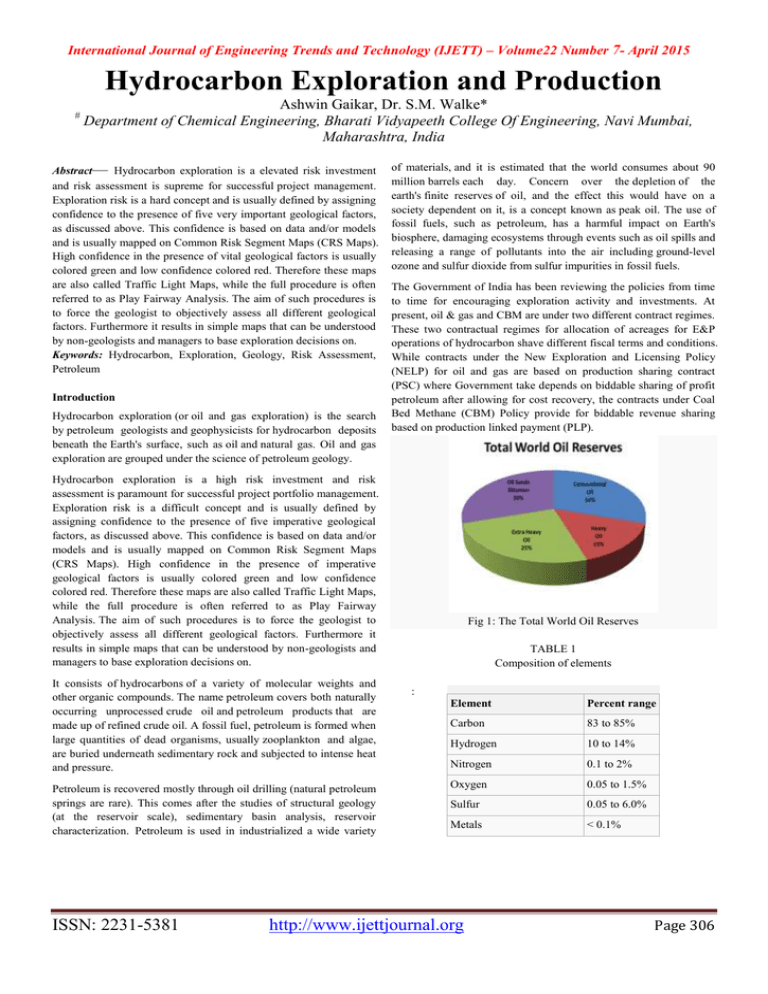
International Journal of Engineering Trends and Technology (IJETT) – Volume22 Number 7- April 2015 Hydrocarbon Exploration and Production # Ashwin Gaikar, Dr. S.M. Walke* Department of Chemical Engineering, Bharati Vidyapeeth College Of Engineering, Navi Mumbai, Maharashtra, India Abstract— Hydrocarbon exploration is a elevated risk investment and risk assessment is supreme for successful project management. Exploration risk is a hard concept and is usually defined by assigning confidence to the presence of five very important geological factors, as discussed above. This confidence is based on data and/or models and is usually mapped on Common Risk Segment Maps (CRS Maps). High confidence in the presence of vital geological factors is usually colored green and low confidence colored red. Therefore these maps are also called Traffic Light Maps, while the full procedure is often referred to as Play Fairway Analysis. The aim of such procedures is to force the geologist to objectively assess all different geological factors. Furthermore it results in simple maps that can be understood by non-geologists and managers to base exploration decisions on. Keywords: Hydrocarbon, Exploration, Geology, Risk Assessment, Petroleum Introduction Hydrocarbon exploration (or oil and gas exploration) is the search by petroleum geologists and geophysicists for hydrocarbon deposits beneath the Earth's surface, such as oil and natural gas. Oil and gas exploration are grouped under the science of petroleum geology. of materials, and it is estimated that the world consumes about 90 million barrels each day. Concern over the depletion of the earth's finite reserves of oil, and the effect this would have on a society dependent on it, is a concept known as peak oil. The use of fossil fuels, such as petroleum, has a harmful impact on Earth's biosphere, damaging ecosystems through events such as oil spills and releasing a range of pollutants into the air including ground-level ozone and sulfur dioxide from sulfur impurities in fossil fuels. The Government of India has been reviewing the policies from time to time for encouraging exploration activity and investments. At present, oil & gas and CBM are under two different contract regimes. These two contractual regimes for allocation of acreages for E&P operations of hydrocarbon shave different fiscal terms and conditions. While contracts under the New Exploration and Licensing Policy (NELP) for oil and gas are based on production sharing contract (PSC) where Government take depends on biddable sharing of profit petroleum after allowing for cost recovery, the contracts under Coal Bed Methane (CBM) Policy provide for biddable revenue sharing based on production linked payment (PLP). Hydrocarbon exploration is a high risk investment and risk assessment is paramount for successful project portfolio management. Exploration risk is a difficult concept and is usually defined by assigning confidence to the presence of five imperative geological factors, as discussed above. This confidence is based on data and/or models and is usually mapped on Common Risk Segment Maps (CRS Maps). High confidence in the presence of imperative geological factors is usually colored green and low confidence colored red. Therefore these maps are also called Traffic Light Maps, while the full procedure is often referred to as Play Fairway Analysis. The aim of such procedures is to force the geologist to objectively assess all different geological factors. Furthermore it results in simple maps that can be understood by non-geologists and managers to base exploration decisions on. It consists of hydrocarbons of a variety of molecular weights and other organic compounds. The name petroleum covers both naturally occurring unprocessed crude oil and petroleum products that are made up of refined crude oil. A fossil fuel, petroleum is formed when large quantities of dead organisms, usually zooplankton and algae, are buried underneath sedimentary rock and subjected to intense heat and pressure. Petroleum is recovered mostly through oil drilling (natural petroleum springs are rare). This comes after the studies of structural geology (at the reservoir scale), sedimentary basin analysis, reservoir characterization. Petroleum is used in industrialized a wide variety ISSN: 2231-5381 Fig 1: The Total World Oil Reserves TABLE 1 Composition of elements : Element Percent range Carbon 83 to 85% Hydrogen 10 to 14% Nitrogen 0.1 to 2% Oxygen 0.05 to 1.5% Sulfur 0.05 to 6.0% Metals < 0.1% http://www.ijettjournal.org Page 306 International Journal of Engineering Trends and Technology (IJETT) – Volume22 Number 7- April 2015 Four different types of hydrocarbon molecules appear in crude oil. The relative percentage of each varies from oil to oil, determining the properties of each oil. TABLE 2 Composition by Weights Hydrocarbon Average Range Alkanes (paraffin) 30% 15 to 60% Naphthenes 49% 30 to 60% Aromatics 15% 3 to 30% Asphaltics 6% Remainder Crude oil varies greatly in appearance depending on its composition. It is usually black or dark brown (although it may be yellowish, reddish, or even greenish). In the reservoir it is usually found in association with natural gas, which being lighter forms a gas cap over the petroleum, and saline water which, being heavier than most forms of crude oil, generally sinks beneath it. Crude oil may also be found in semi-solid form mixed with sand and water, as in the Athabasca oil sands in Canada, where it is usually referred to as crude bitumen. a gaseous state at room temperature. They are the petroleum gases. Depending on demand and the cost of recovery, these gases are either flared off, sold as liquified petroleum gas under pressure, or used to power the refinery's own burners. During the winter, butane (C4H10), is blended into the petrol pool at high rates, because its high vapor pressure assists with cold starts. Liquified under pressure slightly above atmospheric, it is best known for powering cigarette lighters, but it is also a main fuel source for many developing countries. Propane can be liquified under modest pressure, and is consumed for just about every application relying on petroleum for energy, from cooking to heating to transportation. The cycloalkanes, also known as naphthenes, are saturated hydrocarbons which have one or more carbon rings to which hydrogen atoms are attached according to the formula CnH2n. Cycloalkanes have similar properties to alkanes but have higher boiling points. 2. Elements of the Petroleum Prospects A prospect is a potential trap which geologists believe may contain hydrocarbons. A significant amount of geological, structural and seismic investigation must first be completed to redefine the potential hydrocarbon drill location from a lead to a prospect. Five geological factors have to be present for a prospect to work and if any of them fail neither oil nor gas will be present. 1.1 Chemistry A source rock - When organic-rich rock such as oil shale or coal is subjected to high pressure and temperature over an extended period of time, hydrocarbons form. Fig 2: Hydrocarbon compound Octane, a hydrocarbon found in petroleum. Lines represent single bonds; black spheres represent carbon; white spheres represent hydrogen. Petroleum is a mixture of a very large number of different hydrocarbons; the most commonly found molecules are alkanes (paraffins), cycloalkanes (naphthenes), aromatic hydrocarbons, or more complicated chemicals like asphaltenes. Each petroleum variety has a unique mix of molecules, which define its physical and chemical properties, like color and viscosity. The alkanes, also known as paraffin, are saturated hydrocarbons with straight or branched chains which contain only carbon and hydrogen and have the general formula CnH2n+2. They generally have from 5 to 40 carbon atoms per molecule, although trace amounts of shorter or longer molecules may be present in the mixture. The alkanes from pentane (C5H12) to octane (C8H18) are refined into petrol, the ones from nonane (C9H20) to hexadecane (C16H34) into diesel fuel, kerosene and jet fuel. Alkanes with more than 16 carbon atoms can be refined into fuel oil and lubricating oil. At the heavier end of the range, paraffin wax is an alkane with approximately 25 carbon atoms, while asphalt has 35 and up, although these are usually cracked by modern refineries into more valuable products. The shortest molecules, those with four or fewer carbon atoms, are in ISSN: 2231-5381 Reservoir - The hydrocarbons are contained in a reservoir rock. This is commonly a porous sandstone or limestone. The oil collects in the pores within the rock although open fractures within non-porous rocks (e.g. fractured granite) may also store hydrocarbons. The reservoir must also be permeable so that the hydrocarbons will flow to surface during production. Migration - The hydrocarbons are expelled from source rock by three density-related mechanisms: the newly matured hydrocarbons are less dense than their precursors, which causes over-pressure; the hydrocarbons are lighter medium, and so migrate upwards due to buoyancy, and the fluids expand as further burial causes increased heating. Most hydrocarbons migrate to the surface as oil seeps, but some will get trapped. Trap - The hydrocarbons are buoyant and have to be trapped within a structural (e.g. Anticline, fault block) or stratigraphic trap Seal or cap rock - The hydrocarbon trap has to be covered by an impermeable rock known as a seal or cap-rock in order to prevent hydrocarbons escaping to the surface. http://www.ijettjournal.org Page 307 International Journal of Engineering Trends and Technology (IJETT) – Volume22 Number 7- April 2015 2.1 Terms used in Petroleum Evaluation Bright spot - On a seismic section, coda that have high amplitudes due to a formation containing hydrocarbons. Chance of success - An estimate of the chance of all the elements (see above) within a prospect working, described as a probability. Dry hole - A boring that does not contain commercial hydrocarbons. See also Dry hole clause Flat spot - Possibly an oil-water, gas-water or gas-oil contact on a seismic section; flat due to gravity. Hydrocarbon in place - amount of hydrocarbon likely to be contained in the prospect. This is calculated using the volumetric equation - GRV x N/G x Porosity x Sh / FVF GRV - Gross rock volume - amount of rock in the trap above the hydrocarbon water contact N/G - net/gross ratio - proportion of the GRV formed by the reservoir rock ( range is 0 to 1) Porosity - percentage of the net reservoir rock occupied by pores (typically 5-35%) Show - hydrocarbon saturation - some of the pore space is filled with water - this must be discounted FVF - formation volume factor - oil shrinks and gas expands when brought to the surface. The FVF converts volumes at reservoir conditions (high pressure and high temperature) to storage and sale conditions Lead - Potential accumulation is currently poorly defined and requires more data acquisition and/or evaluation in order to be classified as a prospect. Play - An area in which hydrocarbon accumulations or prospects of a given type occur. For example the shale gas plays in North America include the Barnett, Eagle Ford, Fayetteville, Haynesville, Marcellus, and Woodford, among many others. Prospect - a lead which has been more fully evaluated. Recoverable hydrocarbons - amount of hydrocarbon likely to be recovered during production. This is typically 10-50% in an oil field and 50-80% in a gas field. 2.2 Licensing Petroleum resources are typically owned by the government of the host country. In the USA most onshore (land) oil and gas rights (OGM) are owned by private individuals, in which case oil companies must negotiate terms for a lease of these rights with the individual who owns the OGM. Sometimes this is not the same person who owns the land surface. In most nations the government issues licences to explore, develop and produce its oil and gas resources, which are typically administered by the oil ministry. There are several different types of licence. Oil companies often operate in joint ventures to spread the risk; one of the companies in the partnership is designated the operator who actually supervises the work. ISSN: 2231-5381 Tax and Royalty - Companies would pay a royalty on any oil produced, together with a profits tax (which can have expenditure offset against it). In some cases there are also various bonuses and ground rents (license fees) payable to the government - for example a signature bonus payable at the start of the licence. Licences are awarded in competitive bid rounds on the basis of either the size of the work programme (number of wells, seismic etc.) or size of the signature bonus. Production Sharing contract (PSA) - A PSA is more complex than a Tax/Royalty system - The companies bid on the percentage of the production that the host government receives (this may be variable with the oil price), There is often also participation by the Government owned National Oil Company (NOC). There are also various bonuses to be paid. Development expenditure is offset against production revenue. 3. Origin 3.1 Reserves and Reservoirs Resources are hydrocarbons which may or may not be produced in the future. A resource number may be assigned to an undrilled prospect or an unapprised discovery. Appraisal by drilling additional delineation wells or acquiring extra seismic data will confirm the size of the field and lead to project sanction. At this point the relevant government body gives the oil company a production licence which enables the field to be developed. This is also the point at which oil reserves and gas reserves can be formally booked. 3.2 Oil and gas reserves Oil and gas reserves are defined as volumes that will be commercially recovered in the future. Reserves are separated into three categories: proved, probable, and possible. To be included in any reserves category, all commercial aspects must have been addressed, which includes government consent. Technical issues alone separate proved from unproved categories. All reserve estimates involve some degree of uncertainty. Probable reserves are volumes defined as "less likely to be recovered than proved, but more certain to be recovered than Possible Reserves". Some industry specialists refer to this as P50, i.e., having a 50% certainty of being produced. Possible reserves are reserves which analysis of geological and engineering data suggests are less likely to be recoverable than probable reserves. Some industry specialists refer to this as P10, i.e., having a 10% certainty of being produced. The term 1P is frequently used to denote proved reserves; 2P is the sum of proved and probable reserves; and 3P the sum of proved, probable, and possible reserves. The best estimate of recovery from committed projects is generally considered to be the 2P sum of proved and probable reserves. Note that these volumes only refer to currently justified projects or those projects already in development.[6] http://www.ijettjournal.org Page 308 International Journal of Engineering Trends and Technology (IJETT) – Volume22 Number 7- April 2015 Crude oil reservoirs Fig 3: Hydrocarbon trap Three conditions must be present for oil reservoirs to form: a source rock rich in hydrocarbon material buried deep enough for subterranean heat to cook it into oil, a porous and permeable reservoir rock for it to accumulate in, and a cap rock (seal) or other mechanism that prevents it from escaping to the surface.. 3.2 Unconventional oil reservoirs Oil-eating bacteria biodegrade oil that has escaped to the surface. Oil sands are reservoirs of partially biodegraded oil still in the process of escaping and being biodegraded, but they contain so much migrating oil that, although most of it has escaped, vast amounts are still present—more than can be found in conventional oil reservoirs. The lighter fractions of the crude oil are destroyed first, resulting in reservoirs containing an extremely heavy form of crude oil, called crude bitumen in Canada, or extra-heavy crude oil in Venezuela. These two countries have the world's largest deposits of oil sands. 4. Exploration and production Peak oil is the projection that future petroleum production (whether for individual oil wells, entire oil fields, whole countries, or worldwide production) will eventually peak and then decline at a similar rate to the rate of increase before the peak as these reserves are exhausted. The peak of oil discoveries was in 1965, and oil production per year has surpassed oil discoveries every year since 1980. However, this does not mean that potential oil production has surpassed oil demand. peak in world production will be difficult to discern until production clearly drops off. The peak is also a moving target as it is now measured as "liquids", which includes synthetic fuels, instead of just conventional oil. The International Energy Agency (IEA) said in 2010 that production of conventional crude oil had peaked in 2006 at 70 MBBL/d, then flattened at 68 or 69 thereafter. Since virtually all economic sectors rely heavily on petroleum, peak oil, if it were to occur, could lead to a "partial or complete failure of markets". 5. Production at Refinery Although oil and gas are less dense than water and naturally rise up a well to the surface, in reality only 4050% of the total will do so. To enhance recovery, a hole is drilled adjacent to the well and steam is pumped down. The hot water helps to push the oil out of the rock and up into the well. Before it can be used crude oil must be refined. 4.1 Petroleum Production Consumption in the twentieth and twenty-first centuries has been abundantly pushed by automobile growth; the 1985–2003 oil glut even fueled the sales of low economy vehicles in OECD countries. The 2008 economic crisis seems to have had some impact on the sales of such vehicles; still, the 2008 oil consumption shows a small increase. The BRIC countries might also kick in, as China briefly was the first automobile market in December 2009. The immediate outlook still hints upwards. In the long term, uncertainties linger; the OPEC believes that the OECD countries will push low consumption policies at some point in the future; when that happens, it will definitely curb oil sales, and both OPEC and EIA kept lowering their 2020 consumption estimates during the past 5 years. Oil products are more and more in competition with alternative sources, mainly coal and natural gas, both cheaper sources. Hydrocarbons can be separated using distillation, which produces different fractions (or types) of oil and gas Common fractions of petroleum as fuels Boiling range oC Fraction Liquefied petroleum gas (LPG) −40 Butane −12 to −1 Petrol −1 to 110 Jet fuel 150 to 205 Kerosene 205 to 260 Fuel oil 205 to 290 Diesel fuel 260 to 315 4.2 Peak oil Fig 4: Global Peak Oil forecast ISSN: 2231-5381 http://www.ijettjournal.org Fig 5 : Distillation unit Page 309 International Journal of Engineering Trends and Technology (IJETT) – Volume22 Number 7- April 2015 After the distillation of crude oil in refinery we get the different fractions of crude oil as on the top we get the gasoline products such as petrol, diesel, etc. And then we get the different oil composition on the different temperature ranges such as kerosene at 200°c. 6. Applications The chemical structure of petroleum is heterogeneous, composed of hydrocarbon chains of different lengths. Because of this, petroleum may be taken to oil refineries and the hydrocarbon chemicals separated by distillation and treated by other chemical processes, to be used for a variety of purposes. 6.1 Fuels The most common distillation fractions of petroleum are fuels. Fuels include (by increasing boiling temperature range). 6.2. Other derivatives Certain types of resultant hydrocarbons may be mixed with other non-hydrocarbons, to create other end products: Alkenes (olefins), which can be manufactured into plastics or other compounds Lubricants (produces light machine oils, motor oils, and greases, adding viscosity stabilizers as required) Wax, used in the packaging of frozen foods, among others Sulfur or Sulfuric acid. These are useful industrial materials. Sulfuric acid is usually prepared as the acid precursor oleum, a byproduct of sulfur removal from fuels. plastics, pesticides, solvents, adhesives, detergents, etc. and also used for agricultural purpose. 2) The remaining about 16% crude oil is used for the synthesis of all these synthesis materials and for agricultural used. References 1. Research paper on, ―Hydrocarbon exploration and production‖, by P.Macini & E.Mesini, Department of civil, Environmental & material Engineering, University of Baloga, Italy. 2. Research paper on, ―Hydrocarbon exploration and production‖, by Perupetro S.A , Av.Luis Aldona 320, San Borja, Lima 41-Peru. 3. Research paper on, ―Exploration and Production of Hydrocarbons in India‖, by Oil and Natural Gas Corporation in 2012. 4. "Gasoline as Fuel – History of Word Gasoline – Gasoline and Petroleum Origins". Alternative fuels.about.com. 2013-07-12. Retrieved 2013-08-27. 5. Guerriero V. et al. (2012). "A permeability model for naturally fractured carbonate reservoirs". Marine and Petroleum Geology. 6. Kenney, J., Kutcherov, V., Bendeliani, N. and Alekseev, V. (2002). "The evolution of multi component systems at high pressures: VI. The thermodynamic stability of the hydrogen–carbon system: The genesis of hydrocarbons and the origin of petroleum". Bulk tar and Asphalt Petroleum coke, used in specialty carbon products or as solid fuel Paraffin wax and Aromatic petrochemicals to be used as precursors in other chemical production. 6.3 Agriculture Since the 1940s, agricultural productivity has increased dramatically, due largely to the increased use of energyintensive mechanization, fertilizers and pesticides. 7. Conclusion Petroleum, in one form or another, has been used since ancient times, and is now important across society, including in economy, politics and technology. After the exploration of the crude oil from the hydrocarbon rocks from the under the earth surface that are used for different applications, the most common used of the crude oil for refining the different fuels such as petrol, diesel, kerosene, get fuel, etc. Today, about 90 percent of vehicular fuel needs are met by oil. Petroleum also makes up 40 percent of total energy consumption. 1) The about 84% crude oil is used for refining for the different fuels for cars, engines, and machineries. The another remaining crude oil is used for the various purposes like synthesis of ISSN: 2231-5381 http://www.ijettjournal.org Page 310
